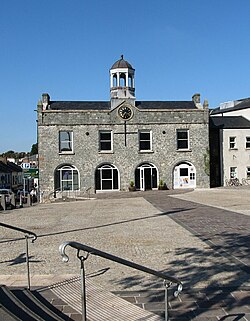Ballynahinch Market House
| Ballynahinch Market House | |
|
County Down | |
|---|---|
 Ballynahinch Market House | |
| Type: | Town hall |
| Location | |
| Grid reference: | J36585242 |
| Location: | 54°24’8"N, 5°53’50"W |
| Village: | Ballynahinch |
| History | |
| Address: | Market Square |
| Built 1795 | |
| Town hall | |
| Neoclassical | |
| Information | |
Ballynahinch Market House, formerly known as Ballynahinch Court House[1] and as Ballynahinch Town Hall, is a municipal structure in the Market Square of Ballynahinch, County Down. The building is today used as a community events venue. It is a Grade B1 listed building.[1]
History
The building was commissioned by John Rawdon, 1st Earl of Moira, whose seat was at Moira Castle, as a covered market for the local people.[1] The foundation stone for the new building was laid by representatives of the local masonic lodge on 2 July 1792.[2] It was designed in the neoclassical style, built in rubble masonry and was completed in 1795.[1][3][4]
The design involved a symmetrical main frontage with four bays facing onto the Market Square; it was arcaded on the ground floor, so that markets could be held, with an assembly room on the first floor. There were four irregular openings with on the ground floor and four sash windows with window cills on the first floor. At roof level, there was a parapet, a central pediment and pinnacles at each end.[1]
In June 1798, a group of United Irishmen, led by Henro Munro, were exposed to a barrage of musketry and artillery fire outside the building in the Market Square in what became known as the Battle of Ballynahinch.[5] Munro was subsequently taken to Lisburn where he was tried and hanged.[6]
In 1802, the building, together with much of the town, was acquired by David Ker, who came to Ballynahinch to "take the waters" from the local medicinal springs.[7] By the 1830s, the building had become dilapidated; it was refurbished in 1841, when a central cupola, in the form of eight columns on a square base supporting a dome, was installed on the roof and a clock, made by James Scott and Sons, was installed in the central pediment.[1]
The assembly room was used as a court room for petty session hearings throughout the 19th century[8] and it was also used as a classroom for lessons in science and technology in the late 19th century.
In May 1935, the Ker family sold the building to William James McCoubrey, who was a local businessman and chairman of the council.[9] McCoubrey converted the ground floor of the building for retail use and the first floor for use as a working men's club. In 1957, he replaced the cupola with a small pyramid-shaped spire and he subsequently infilled the openings at the front of the building with glazing.[1]
In January 2001, a group of local people, the Ballynahinch Regeneration Committee, acquired the building from the McCoubrey family. An extensive programme of refurbishment works, which involved the removal of cement render from the front building, establishing regular openings with voussoirs on the ground floor and the restoration of the cupola in the original style, was completed in 2002. The local council then acquired the building for use as a community events venue in August 2010.
References
- ↑ 1.0 1.1 1.2 1.3 1.4 1.5 1.6 "Old Court House, AKA Former market house, The Square, Ballynahinch, Co. Down (HB 18/07/005)". Department for Communities. https://apps.communities-ni.gov.uk/Buildings/buildview.aspx?id=4682&js=false.
- ↑ Ulster Folklife. 19–28. Ulster Folk and Transport Museum. 1973. p. 97. https://www.google.com/books/edition/Ulster_Folklife/UonGIc-NMOYC?hl=en&gbpv=. "The Master, Wardens and Brethren of Lodge 446… return their grateful thanks to the Right Honourable the Earl of Moira for his Lordship's condescension in permitting them, on Monday the 2nd inst. to lay the first stone of a Market House, which his Lordship is about to have built in the town of Ballynahinch (From The Northern Star, 11 July 1792)"
- ↑ "1795: Market House, Ballynahinch, Co. Down". Archiseek. https://www.archiseek.com/2015/1795-market-house-ballynahinch-co-down/.
- ↑ Brett, Charles Edward Bainbridge (1973). Court Houses and Market Houses of the Province of Ulster. Ulster Architectural Heritage Society. p. 65. ISBN 978-0900457081. https://www.google.com/books/edition/Court_Houses_and_Market_Houses_of_the_Pr/Dfw2AQAAIAAJ?hl=en&gbpv=.
- ↑ Webb, Alfred (1878). A Compendium of Irish Biography, Comprising Sketches of Distinguished Irishmen, and of Eminent Persons Connected with Ireland by Office Or by Their Writings. M. H. Gill and Son. https://www.libraryireland.com/biography/HenryMunro.php.
- ↑ Proudfoot, L. (1997). Down History and Society. Dublin: Geography Publications. p. 289. ISBN 978-0906602805.
- ↑ Leslie, Rose Jane; Sloan, Gerard: 'Old Ballynahinch' (Stenlake Publishing, 2012) ISBN 9781840335811; page=3
- ↑ "Ballynahinch Town Centre Master Plan". Newry, Mourne and Down District Council. p. 10. https://www.newrymournedown.org/media/uploads/ballynahinch_master_plan.pdf.
- ↑ "Obituary: Chairman of county council Mr. William James McCoubrey, of High Street, Ballynahinch, who has died.". Belfast Telegraph: p. 5. 21 September 1968.